Electrosurgery in Dentistry: Techniques, Benefits, and Best Practices
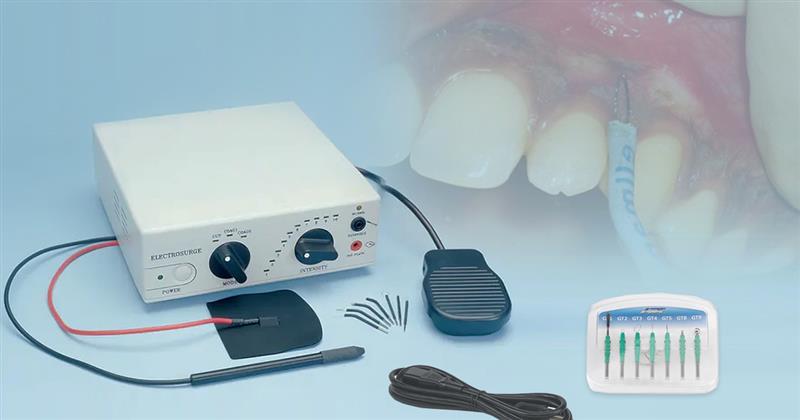
Over the last few decades, there has been a noticeable shift towards bloodless or minimally invasive techniques in dental surgery. One of the most effective methods, in practice for over 50 years, is electrosurgery. Despite its proven track record, many dentists remain cautious or skeptical about incorporating it into their daily practice.
This blog introduces you to electrosurgery, highlighting its benefits and applications in dentistry. By providing controlled surgical effects with minimal bleeding, electrosurgery offers significant advantages in various dental procedures. We will cover the fundamentals of electrosurgery, how it works, and where it can be most beneficial in clinical settings. Whether you’re considering using electrosurgery in your practice or simply curious about its capabilities, this guide will help you understand its full potential in modern dentistry.
What is Electrosurgery?
Electrosurgery is the intentional passage of high-frequency waveforms or currents through body tissues to achieve a controlled surgical effect. With the high-frequency waveform produced, the tissue can either be sliced or coagulated. This treatment is often referred to as bloodless surgery, as the electrode causes the tissue to shrink, sealing the capillaries on either side.
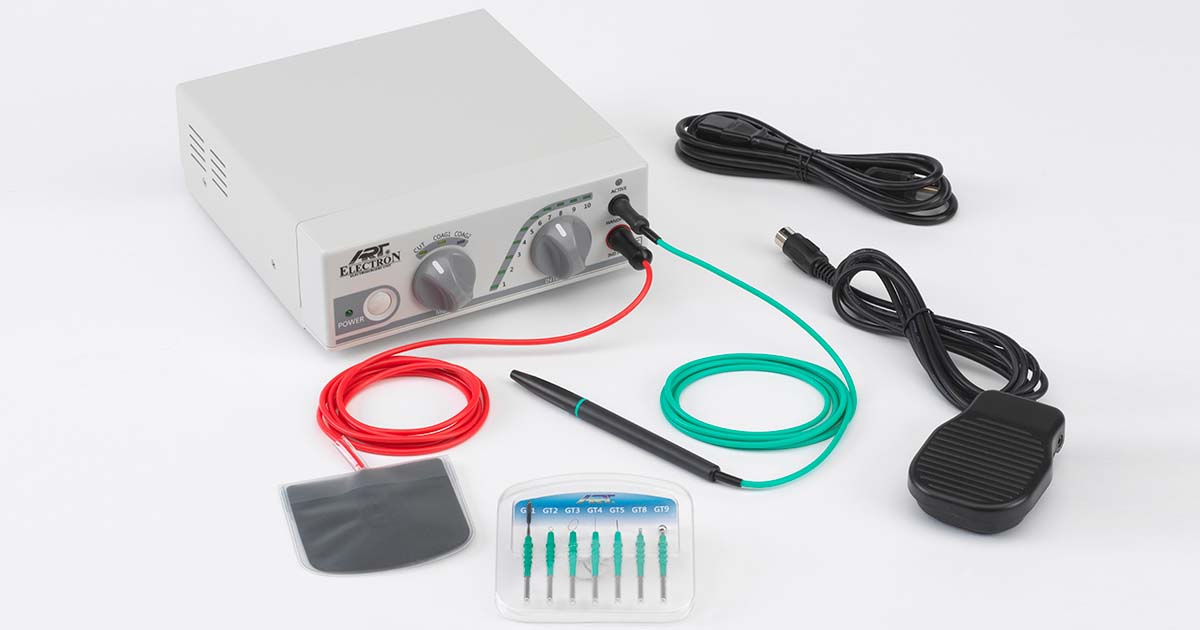
Principle of Electrosurgery:
The electromagnetic energy in the tissue is transformed within the cells when radiofrequency electrical current is introduced, first into kinetic energy and subsequently into heat energy. The size and shape of the electrode in contact with the operative site, along with tissue exposure time, determine the effect on the target tissue. The entire process involves the following wiring and equipment: connecting wires, electrodes, an electrosurgical machine to create a circuit, and a patient.
There are two types of electrosurgical units – bipolar and unipolar.
The bipolar type has two separate electrodes attached to the same tip of a handpiece or probe, with current flowing from one electrode to the other, affecting only the tissue in between.
In the unipolar type, the electric flow starts from the electrosurgical unit to the intraoral tissue being operated on and flows to the return plate, which is placed on the patient’s back or thigh. When the oral tissue is touched, heat is generated, and controlled cutting of the tissue is achieved.
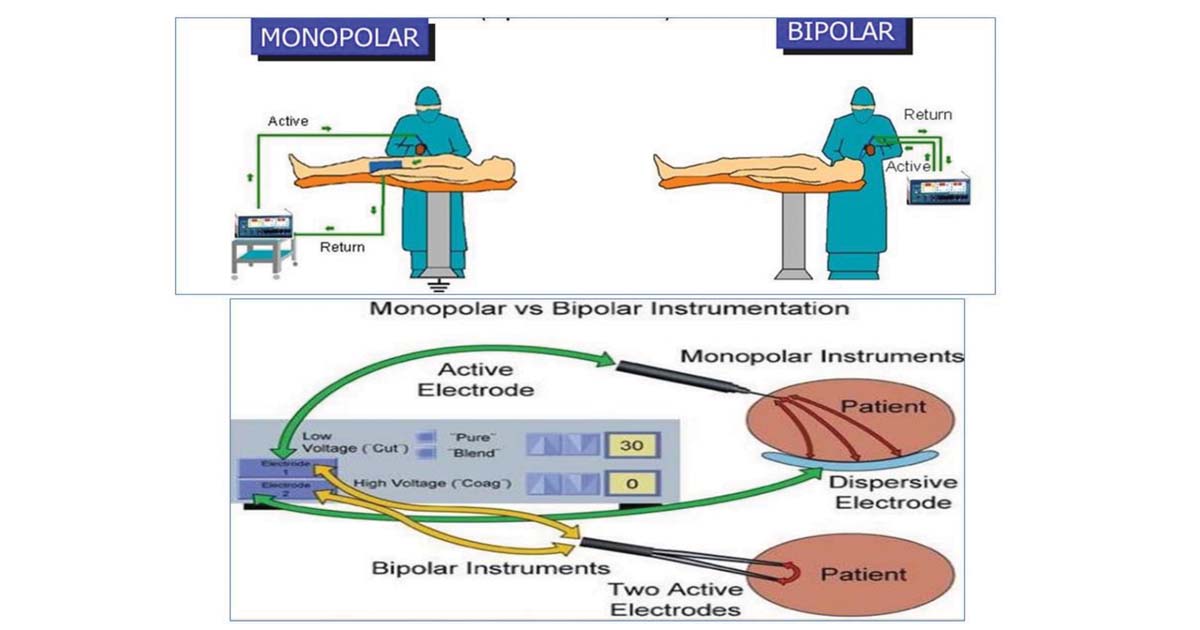
Electrodes:
There are two types of electrodes in an electrosurgery unit: active electrodes, which serve as the cutting tip, and passive electrodes, which serve as an antenna to bring the radio signal back to the electrosurgical unit.
Active electrodes, used for coagulating and cutting tissue, are available in different shapes and sizes depending on the intended use. Some may resemble a needle and are used for cutting tissues, whereas electrodes with a large surface area at the tip may be utilized to coagulate tissues.
Passive electrodes are also available in different types, such as Permaground, coated/insulated passive electrodes, metallic waistbands, and metallic hand-held rods, etc.
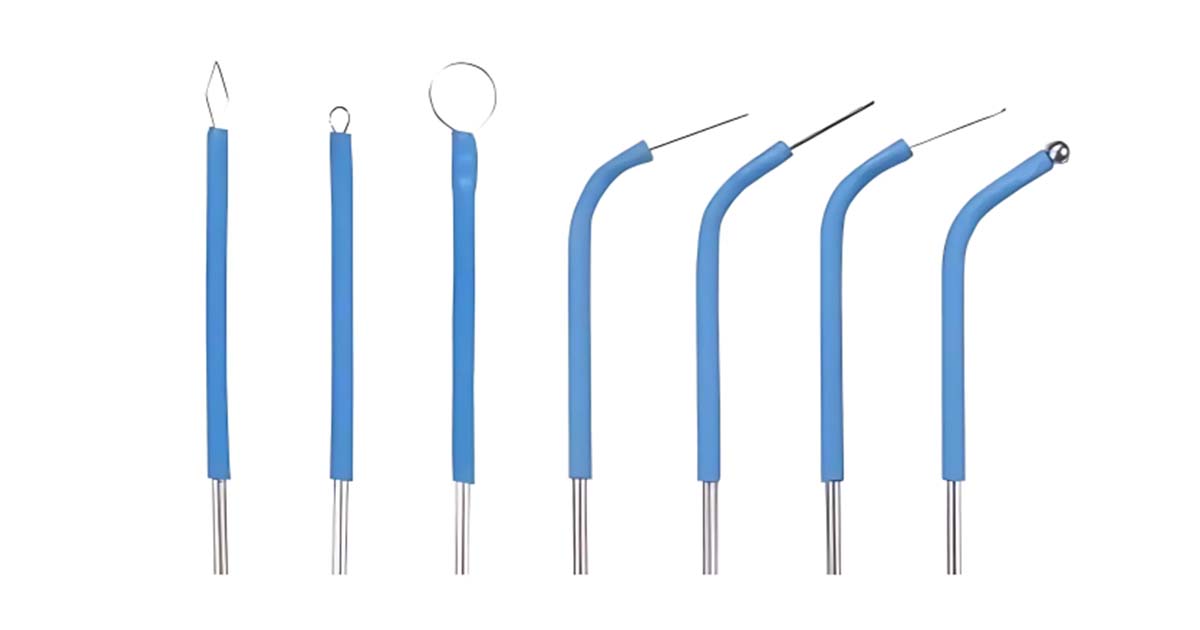
Variables affecting Electrosurgery:
Lateral Heat: Lateral heat refers to the considerable amount of heat generated by the tissue’s electrical wave resistance. A waveform is selected based on the intended use of the electrosurgical unit, and with different waveforms, varying amounts of lateral heat are produced. The amount of lateral heat decreases when the active electrode is moved over the tissue as quickly as possible.
A number of investigations have been conducted to study lateral heat formation under different conditions, leading to various inferences. One study discovered that the temperature rose from 5 to 86°F, influenced by factors such as the current type, application time, and distance from the electrode. Other studies showed that to prevent the damaging effects of lateral heat on the tissue, there should be a minimum gap of 8 seconds between each subsequent incision in the same area.
It was also later inferred that a loop-activated electrode produced more energy than a needle electrode and required a cooling break of 15 seconds to effectively disperse the heat between subsequent incisions in the same location of the tissue.
Waveform: The choice of waveform depends on two points –
- The required surgical effect, i.e., whether tissue separation is needed or hemostasis is required.
- The proximity of the bone to the surgical site.
A fully rectified waveform produces excellent tissue separation with the least amount of lateral heat, but it also provides hemostasis, though only in minimal amounts.
A fully rectified, unfiltered waveform compensates for the previous one by producing good tissue separation and effective hemostasis.
A partially rectified waveform produces more heat than the fully rectified, unfiltered waveform and hence, can be used only for hemostasis of soft tissues.
Cutting Time: The quicker the active electrode is passed over the tissue, the less lateral heat is produced. The electrode must be guided over the tissue at a speed of 7 mm/s to generate an effective incision while keeping lateral heat minimal. The active electrode should not remain in contact with the operative site for more than 1–2 seconds at a time, and successive applications should have an interval of about 8 to 15 seconds, depending on the type of electrode used, allowing effective heat dissipation before tissue overheating.
Surface tissue condition: The surface of the tissue being operated on should always be moist to allow heat dispersal. It is desirable for the tissue to be wetted by the patient’s own saliva, water, or saline. Dehydrated tissue causes sparking, tissue drag, and delayed healing. Additionally, irrigating the tissue area after electrosurgery minimizes lateral heat.
Basic Electrosurgery Techniques and Terminologies:
Electrocoagulation: Helps in coagulation or hemorrhage control by using electrocoagulation current. The active electrodes used for electrocoagulation are much bulkier than the ones used for electrosection.
Electrosection: Also known as electrotomy or acusection, it is used for incisions, excisions, and tissue planing. This technique uses single-wire active electrodes that can be bent or adapted to accomplish any type of cutting procedure.
Electrofurgulation: Used for destroying abnormal tissues such as tumors.
Electrodissection: Used to remove basal cell and squamous cell carcinomas.
Hoewever, in dentistry only the first two types are predominantly used.
Indications of Electrosurgery :
- Incision and drainage of abscesses
- Gingivectomy and gingivoplasty procedures
- Operculectomy
- Frenectomies
- Elongation of clinical crowns
- Troughing of crown and bridges impressions
- Incisional and excisional biopsies for cysts or tumors
- Periodontal Pocket Reduction
- Hemostasis
- Depigmentation of gingiva
- Exposure of Impacted teeth during orthodontic treatment
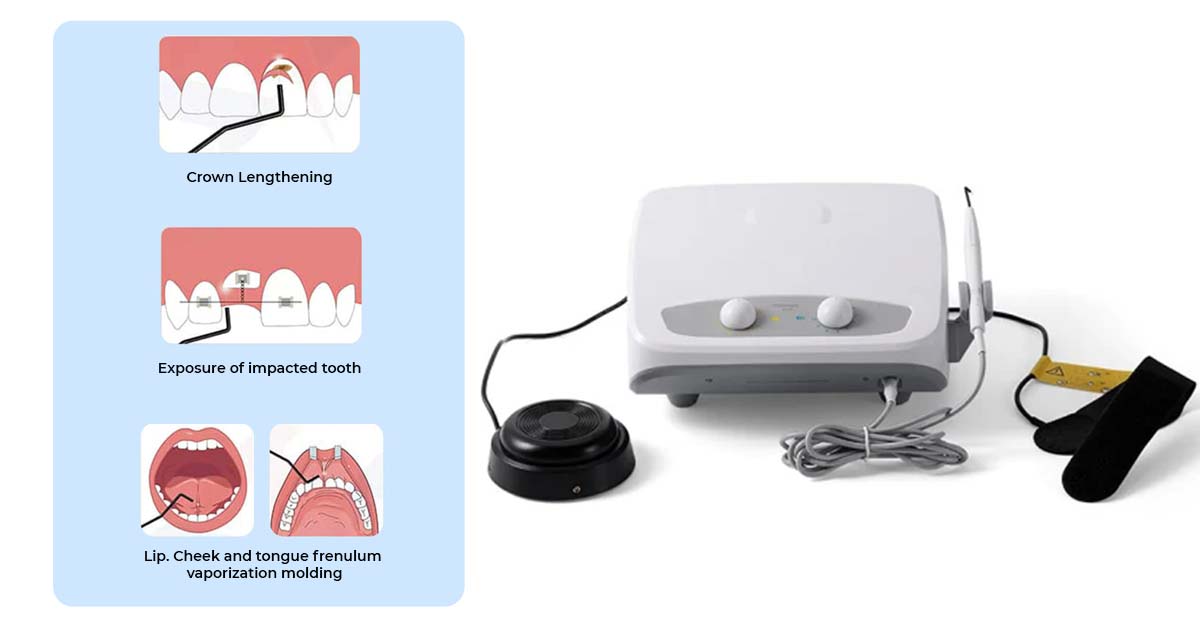
Contraindications of Electrosurgery :
- Patients with pacemakers cannot be treated with monopolar electrosurgery, as the high-frequency electrical signals used can cause electromagnetic interference (EMI), which may lead to pacemaker malfunction or reprogramming.
- Electrosurgery should not be used in areas close to the bone, as the heat generated can cause bone necrosis or damage, especially with monopolar electrosurgery.
Advantages of Electrosurgery:
- Minimal bleeding post incision
- Bloodless field of operation
- Clean tissue separation with no or very little bleeding
- Pressureless and precise technique
- Soft tissue planing is possible
- Minimal scar formation and healing discomfort.
- Can be used in difficult to reach areas
- Reduced chair time and operator fatigue
Disadvantages of Electrosurgery :
- The odor of burning tissue is unacceptable to some patients.
- Electrosurgery cannot be used near flammable gases, as the spark can trigger an explosion when an electrosurgical unit is activated.
- The initial cost is significantly higher compared to a simple scalpel.
Post-operative Instructions for Effective Wound Healing:
- Strict refrainment from smoking, alcohol consumption, eating hard or spicy foods, drinking citrus beverages, and consuming other tobacco products should be followed by the patient.
- Regions not involved in the operative site can be cleaned with a toothbrush cautiously by the patient.
- Cold packs should be instructed to the patient to reduce any swelling post-procedure.
- Analgesics should be prescribed to provide relief for any discomfort that might occur post-procedure.
- The patient should be instructed to call the doctor if any emergency occurs.
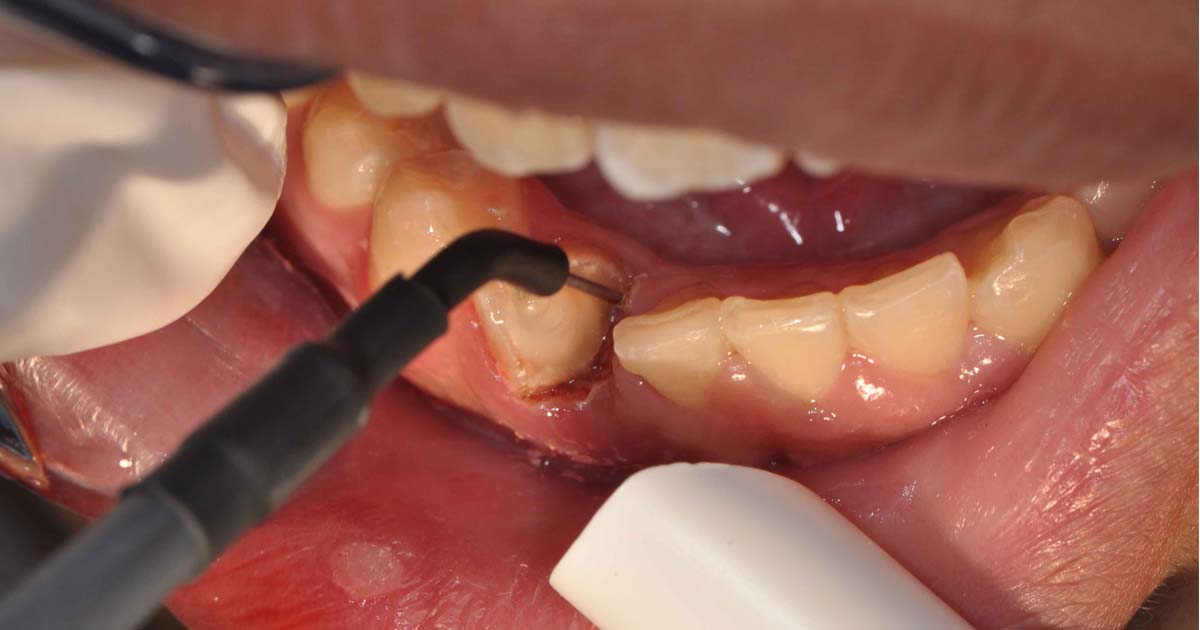
Guideline to use Electrosurgical unit:
Krejci et al. have given the following protocol to be followed during electrosurgery:
- A fully rectified, filtered high-frequency waveform should be used to create intraoral incisions.
- The smallest electrode should be used to make an incision.
- Electrosurgical incisions should be made at a minimum rate of 7 mm/s.
- A cooling period of 8 seconds should be given between two successive incisions with a needle at the same surgical site. For excisional procedures with loop-type electrodes, this should be 15 seconds.
- In areas where connective tissue reattachment is desired, contact of the active electrode of the electrosurgery unit must be avoided with the cemental surface of the tooth.
- A slight amount of gingival recession should be anticipated when an electrosurgical incision is made for troughing or excision of the gingival crevice.
- Contact of the active electrode with metallic restorations should be limited to a period of less than 0.4 seconds to prevent pulpal damage.
- It can be effectively used for pulpotomy procedures.
- Excessive contact with the alveolar bone can result in irreversible changes and may lead to the loss of periodontal support.
- The use of the electrosurgical unit to provide fulgurating sparks for obtaining hemorrhage control should be used only after all other methods have been exhausted, as a delayed healing response is often expected afterward.
- Excision of inflammatory papillary hyperplasia can be done with the electrosurgery unit conveniently.
Conclusion:
Electrosurgery is a valuable tool in modern dentistry, offering precise tissue modification with minimal bleeding, improved visibility, and faster procedures. Understanding its principles, indications, and contraindications is essential for safe and effective use. While electrosurgery presents numerous advantages, including reduced healing time and enhanced surgical precision, careful technique and adherence to established guidelines are necessary to prevent tissue damage and ensure optimal outcomes.
For dentists looking to incorporate electrosurgery into their practice, the Domed High-Frequency Electrosurgery Unit is a reliable and efficient option available on DentalKart, designed to enhance surgical precision while ensuring patient comfort.
Domed High-Frequency Electrosurgery Unit

Precision & Safety: Fine-tuned incision and coagulation settings with filtered, constant current ensure safe and accurate tissue handling.
Compact & Easy to Use: Reliable, lightweight unit with simple controls (only two potentiometers) for quick setup in clinical settings.
Complete Accessory Set: Comes with everything needed to get started, including 7 hyperfine electrodes, electrode holder with cord, footswitch, power cable, silicone pads, neutral electrode bracelet, and manuals.
Sterilizable & Protective Design: Autoclavable electrode holder and insulated electrodes minimize cross-infection and accidental injury.
High Safety Standards: Floating high-frequency output with conductive wristband (neutral electrode) for enhanced patient safety.
Optimized Performance: Delivers up to 30W power output with 1.2 MHz ± 0.2 MHz frequency—ideal for most soft tissue procedures in dental and medical practice.
Frequently Asked Questions:
Electrosurgery in dentistry is used for various procedures, such as gingivectomy, frenectomies, crown elongation, periodontal pocket reduction, and biopsies for cysts or tumors. It is especially useful for controlling hemorrhage and performing bloodless surgeries in delicate areas.
The four main types of electrosurgery are electrocoagulation (for controlling bleeding), electrosection (for cutting and excising tissue), electrofurgulation (for destroying abnormal tissues like tumors), and electrodissection (used for removing certain carcinomas).
Electrosurgery offers a bloodless field, minimal bleeding, and precise tissue separation, which results in cleaner procedures and faster healing. It can be used in hard-to-reach areas, reduces chair time, and minimizes scarring and post-operative discomfort. Additionally, it’s effective in controlling hemorrhage and enhances overall surgical precision.

No Comment